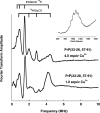The octarepeat domain of the prion protein binds Cu(II) with three distinct coordination modes at pH 7.4
- PMID: 16144413
- PMCID: PMC2909831
- DOI: 10.1021/ja053254z
The octarepeat domain of the prion protein binds Cu(II) with three distinct coordination modes at pH 7.4
Abstract
The prion protein (PrP) binds Cu2+ in its N-terminal octarepeat domain. This unusual domain is comprised of four or more tandem repeats of the fundamental sequence PHGGGWGQ. Previous work from our laboratories demonstrates that at full copper occupancy, each HGGGW segment binds a single Cu2+. However, several recent studies suggest that low copper occupancy favors different coordination modes, possibly involving imidazoles from histidines in adjacent octapeptide segments. This is investigated here using a combination of X-band EPR, S-band EPR, and ESEEM, along with a library of modified peptides designed to favor different coordination interactions. At pH 7.4, three distinct coordination modes are identified. Each mode is fully characterized to reveal a series of copper-dependent octarepeat domain structures. Multiple His coordination is clearly identified at low copper stoichiometry. In addition, EPR detected copper-copper interactions at full occupancy suggest that the octarepeat domain partially collapses, perhaps stabilizing this specific binding mode and facilitating cooperative copper uptake. This work provides the first complete characterization of all dominant copper coordination modes at pH 7.4.
Figures








References
Publication types
MeSH terms
Substances
Grants and funding
LinkOut - more resources
Full Text Sources
Molecular Biology Databases
Research Materials
Miscellaneous

